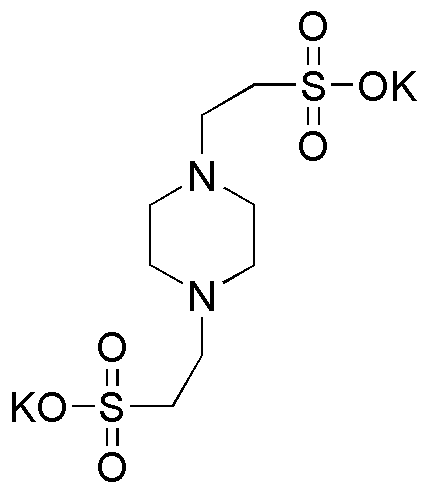Piperazine-N,N'-bis(2-ethanesulfonic acid) dipotassium salt is widely utilized in research focused on:
- Biological Buffering: This compound serves as an effective buffering agent in biological and biochemical research, helping to maintain pH stability in various experiments, which is crucial for enzyme activity and cellular processes.
- Pharmaceutical Formulations: It is used in the development of drug formulations, particularly in stabilizing active ingredients and enhancing solubility, making it valuable in the pharmaceutical industry.
- Cell Culture Applications: Researchers use this compound in cell culture media to support cell growth and maintain optimal conditions, which is essential for studies in cellular biology and drug testing.
- Electrophoresis: It plays a role in electrophoresis techniques, where it helps to separate biomolecules based on size and charge, facilitating research in genetics and proteomics.
- Environmental Testing: The compound is also applied in environmental science for testing water quality, as it can help in the analysis of pollutants and other substances in aquatic systems.
Información general
Propiedades
Seguridad y normativas
Aplicaciones
Piperazine-N,N'-bis(2-ethanesulfonic acid) dipotassium salt is widely utilized in research focused on:
- Biological Buffering: This compound serves as an effective buffering agent in biological and biochemical research, helping to maintain pH stability in various experiments, which is crucial for enzyme activity and cellular processes.
- Pharmaceutical Formulations: It is used in the development of drug formulations, particularly in stabilizing active ingredients and enhancing solubility, making it valuable in the pharmaceutical industry.
- Cell Culture Applications: Researchers use this compound in cell culture media to support cell growth and maintain optimal conditions, which is essential for studies in cellular biology and drug testing.
- Electrophoresis: It plays a role in electrophoresis techniques, where it helps to separate biomolecules based on size and charge, facilitating research in genetics and proteomics.
- Environmental Testing: The compound is also applied in environmental science for testing water quality, as it can help in the analysis of pollutants and other substances in aquatic systems.
Documentos
Hojas de datos de seguridad (HDS)
La SDS proporciona información de seguridad completa sobre la manipulación, el almacenamiento y la eliminación del producto.
Especificación del producto (PS)
La PS proporciona un desglose completo de las propiedades del producto, incluida la composición química, el estado físico, la pureza y los requisitos de almacenamiento. También detalla los rangos de calidad aceptables y las aplicaciones previstas del producto.
Certificados de análisis (COA)
Busque certificados de análisis (COA) ingresando el número de lote del producto. Los números de lote y de partida se pueden encontrar en la etiqueta de un producto después de las palabras "Lote" o "Lote".
Número de catálogo
Número de lote/lote
Certificados de origen (COO)
Este certificado de origen confirma el país en el que se fabricó el producto y también detalla los materiales y componentes utilizados en él y si se deriva de fuentes naturales, sintéticas u otras fuentes específicas. Este certificado puede ser necesario para cumplir con las normativas aduaneras, comerciales y regulatorias.
Número de catálogo
Número de lote/lote
Hojas de datos de seguridad (HDS)
La SDS proporciona información de seguridad completa sobre la manipulación, el almacenamiento y la eliminación del producto.
DownloadEspecificación del producto (PS)
La PS proporciona un desglose completo de las propiedades del producto, incluida la composición química, el estado físico, la pureza y los requisitos de almacenamiento. También detalla los rangos de calidad aceptables y las aplicaciones previstas del producto.
DownloadCertificados de análisis (COA)
Busque certificados de análisis (COA) ingresando el número de lote del producto. Los números de lote y de partida se pueden encontrar en la etiqueta de un producto después de las palabras "Lote" o "Lote".
Número de catálogo
Número de lote/lote
Certificados de origen (COO)
Este certificado de origen confirma el país en el que se fabricó el producto y también detalla los materiales y componentes utilizados en él y si se deriva de fuentes naturales, sintéticas u otras fuentes específicas. Este certificado puede ser necesario para cumplir con las normativas aduaneras, comerciales y regulatorias.


